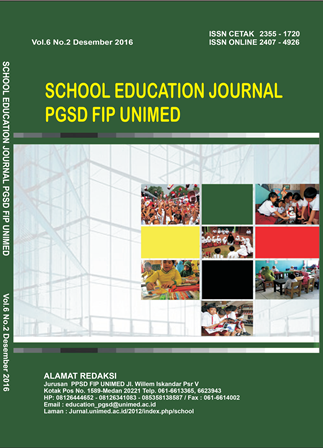MENINGKATKAN HASIL BELAJAR SISWA MENGGUNAKAN MODEL PEMBELAJARAN GROUP INVESTIGATION (GI) PADA MATERI PERSAMAAN LINIER SATU VARIABELDI KELAS VII-2 SMP NEGERI 1 TANJUNG MORAWA
DOI:
https://doi.org/10.24114/sejpgsd.v6i2.5921Abstract
ABSTRAKPenelitian ini merupakan penelitian tindakan kelas dengan menggunakan Model Pembelajaran Group Investigation (GI) Pada Materi Persamaan linier Satu Variabel dengan tujuan untuk mengetahui peningkatan hasil belajar siswa. Hasil penelitian pada saat tes awal diperoleh nilai rata-rata sebesar 55,94, menjadi 74,05 pada tes siklus I dan meningkat menjadi 81,35 pada tes siklus II. Adapun tingkat pemahaman konsep yang telah dipelajari pada indicator menyatakan ulang konsep yang telah dipelajari ketuntasan yang diperolah siswa pada siklus I 78,38 %(29 orang) meningkat pada siklus II 83,78 %(31 orang), pada indicator memberi contoh dan non contoh pada siklus I 62,16% (23 orang) meningkat pada siklus II 86,49% (32 orang), pada indicator menggunakan, memanfaatkan dan memilih prosedur tertentu pada siklus I 59,46% (22 orang) meningkat pada siklus II 72,97%(27 orang). Kata kunci : Hasil belajar, Group investigation, Persamaan linier satu variableDownloads
Published
Issue
Section
License
Authors whose manuscripts are approved are approved as follows:
The publication rights for all journal manuscript materials published/published on the SEJ (School Education Journal) E-Journal site are held by the editorial board with the author's knowledge (moral rights remain with the manuscript authors).
The formal legal requirements for accessing this electronic digital journal article are subject to the terms of the Creative Commons Attribution-ShareAlike (CC BY) license, which means that E-Journal SEJ (School Education Journal) has the right to store, transfer media/format, manage in the form of a database, maintain, and publish articles without asking permission from the author as long as the author's name remains as the copyright owner.
Manuscripts published/published electronically are open access for educational, research, and library purposes.

